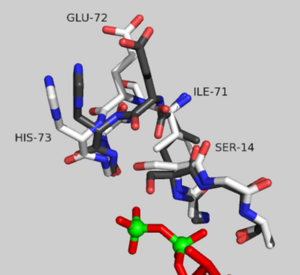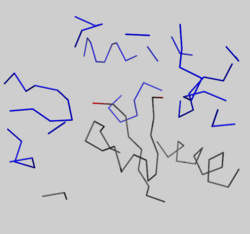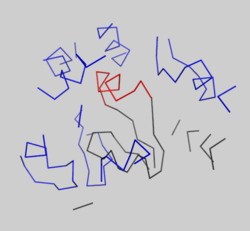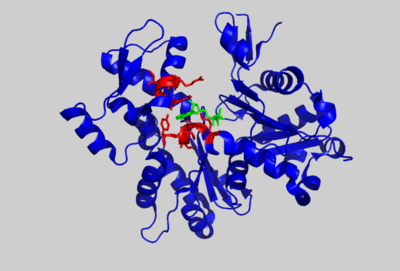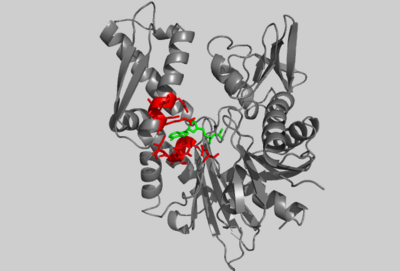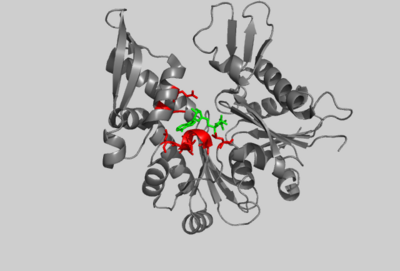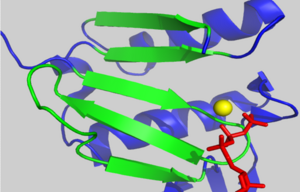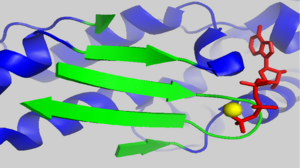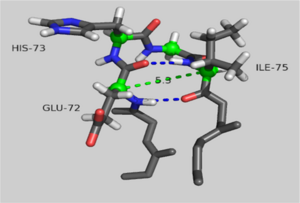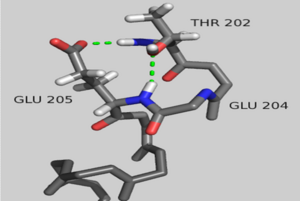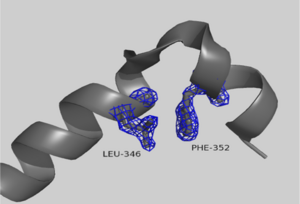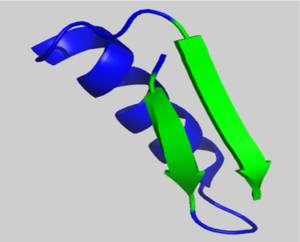Non-polymerizable monomeric actin
From Proteopedia
(Difference between revisions)
| Line 15: | Line 15: | ||
<scene name='User:Thomas_E_Sladewski/Sandbox_1/10state_morph_scene2/2'>Morph of AP-actin showing conformational changes between actin bound to ATP</scene> (PDB entry [[2HF4]]) and ADP (PDB entry [[2HF3]]). Nucleotide is not shown. | <scene name='User:Thomas_E_Sladewski/Sandbox_1/10state_morph_scene2/2'>Morph of AP-actin showing conformational changes between actin bound to ATP</scene> (PDB entry [[2HF4]]) and ADP (PDB entry [[2HF3]]). Nucleotide is not shown. | ||
| - | [[Image:2HF4 REDO OF MORPH STILL IMAGE.png|300px| | + | [[Image:2HF4 REDO OF MORPH STILL IMAGE.png|300px|left|thumb| Sensor loop of AP-actin bound to ADP (grey) and ATP (white)]] |
| - | + | {{clear}} | |
Structural changes between the ATP and ADP-bound state of <scene name='User:Thomas_E_Sladewski/Sandbox_1/10state_morph_all_activesite/1'> AP-actin </scene> are confined to the active site. The <scene name='User:Thomas_E_Sladewski/Sandbox_1/10state_morph_scene2/3'> alpha-carbon backbones </scene> of the two states outside the sensor loop region superimpose very well, with a RMSD of 0.19 angstroms. A close-up of the <scene name='User:Thomas_E_Sladewski/Sandbox_1/10state_morph_sensorloop/5'> active site </scene> reviles how binding ATP elicits structural changes in the nucleotide-binding cleft that is propagated to the sensor loop. When actin is bound to ADP, the serine-14 side chain forms a hydrogen bind with the beta phosphate ADP. Upon ATP binding, the gamma phosphate sterically clashes with the oxygen of serine-14, forcing the hydroxyl to rotate 130°. The displaced serine residue impinges on the backbone carbonyls of residues isoleucine-71 and glutamic acid-72 in the sensor loop. This causes a 180° rotation of the peptide linkage between glutamic acid-72 and histidine-73. These structural changes impact residues proximal to the sensor loop. Transition to the ATP-bound state causes glutamic acid-72 to form a new hydrogen bond with threonine-77. This induces a reorientation of <scene name='User:Thomas_E_Sladewski/Sandbox_1/10state_morph_sensorloop_add/5'>asparagine-78</scene>. ATP binding also disrupts hydrogen bonding between arginine-183 and residues 72 and 73 of the sensor loop causing a conformational change of <scene name='User:Thomas_E_Sladewski/Sandbox_1/10state_morph_sensorloop_add/6'>arginine-183</scene>. Aspartic acid-179 stacks against histidine-73 in the ATP-bound state which induces a shift in the position of <scene name='User:Thomas_E_Sladewski/Sandbox_1/10state_morph_sensorloop_add/7'>arginine-177 </scene> to improve salt bridge formation with aspartic acid-179. In the AP-actin structure, changes in conformation due ATP binding are local to the active site and do not appear to propagate into domains. | Structural changes between the ATP and ADP-bound state of <scene name='User:Thomas_E_Sladewski/Sandbox_1/10state_morph_all_activesite/1'> AP-actin </scene> are confined to the active site. The <scene name='User:Thomas_E_Sladewski/Sandbox_1/10state_morph_scene2/3'> alpha-carbon backbones </scene> of the two states outside the sensor loop region superimpose very well, with a RMSD of 0.19 angstroms. A close-up of the <scene name='User:Thomas_E_Sladewski/Sandbox_1/10state_morph_sensorloop/5'> active site </scene> reviles how binding ATP elicits structural changes in the nucleotide-binding cleft that is propagated to the sensor loop. When actin is bound to ADP, the serine-14 side chain forms a hydrogen bind with the beta phosphate ADP. Upon ATP binding, the gamma phosphate sterically clashes with the oxygen of serine-14, forcing the hydroxyl to rotate 130°. The displaced serine residue impinges on the backbone carbonyls of residues isoleucine-71 and glutamic acid-72 in the sensor loop. This causes a 180° rotation of the peptide linkage between glutamic acid-72 and histidine-73. These structural changes impact residues proximal to the sensor loop. Transition to the ATP-bound state causes glutamic acid-72 to form a new hydrogen bond with threonine-77. This induces a reorientation of <scene name='User:Thomas_E_Sladewski/Sandbox_1/10state_morph_sensorloop_add/5'>asparagine-78</scene>. ATP binding also disrupts hydrogen bonding between arginine-183 and residues 72 and 73 of the sensor loop causing a conformational change of <scene name='User:Thomas_E_Sladewski/Sandbox_1/10state_morph_sensorloop_add/6'>arginine-183</scene>. Aspartic acid-179 stacks against histidine-73 in the ATP-bound state which induces a shift in the position of <scene name='User:Thomas_E_Sladewski/Sandbox_1/10state_morph_sensorloop_add/7'>arginine-177 </scene> to improve salt bridge formation with aspartic acid-179. In the AP-actin structure, changes in conformation due ATP binding are local to the active site and do not appear to propagate into domains. | ||
[[Image:2hf4 d loop crystal packing.png|250px|left|thumb| Crystal packing interactions between ADP-bound AP-actin, (grey ribbon) and neighboring residues in subdomain 2 of an adjacent monomer in the crystal within 15 angstroms of the D-loop in the unit cell (blue ribbons). Residues 39-50 are shown in red.]] | [[Image:2hf4 d loop crystal packing.png|250px|left|thumb| Crystal packing interactions between ADP-bound AP-actin, (grey ribbon) and neighboring residues in subdomain 2 of an adjacent monomer in the crystal within 15 angstroms of the D-loop in the unit cell (blue ribbons). Residues 39-50 are shown in red.]] | ||
| + | {{clear}} | ||
[[Image:1J6Z d loop crystal packing.png|250px|left|thumb| Crystal packing interactions between ADP-actin, complexed with TMR (grey ribbon)(PDB entry [[1J6Z]]) and neighboring residues in subdomain 2 of an adjacent monomer in the crystal within 15 angstroms of the D-loop in the unit cell (blue ribbons). Residues 39-50 are shown in red.]] | [[Image:1J6Z d loop crystal packing.png|250px|left|thumb| Crystal packing interactions between ADP-actin, complexed with TMR (grey ribbon)(PDB entry [[1J6Z]]) and neighboring residues in subdomain 2 of an adjacent monomer in the crystal within 15 angstroms of the D-loop in the unit cell (blue ribbons). Residues 39-50 are shown in red.]] | ||
| - | + | {{clear}} | |
===The D-loop=== | ===The D-loop=== | ||
<scene name='User:Thomas_E_Sladewski/Sandbox_1/10state_d_loop_morph/2'>Morph of subdomain 2 of actin complexed with TMR in the ADP state and actin complexed with DNAse I in the ATP state</scene> <ref name="TMR"/>. | <scene name='User:Thomas_E_Sladewski/Sandbox_1/10state_d_loop_morph/2'>Morph of subdomain 2 of actin complexed with TMR in the ADP state and actin complexed with DNAse I in the ATP state</scene> <ref name="TMR"/>. | ||
There is some controversy over whether or not the D-loop undergoes structural changes upon actin binding ATP. In the structure of AP-actin, the D-loop is disordered in both the ATP and ADP-bound state. Also, there is no evidence that structural changes in the nucleotide binding cleft propagate to subdomain 2. This argues that the D-loop remains disordered in both states. However, other groups show large ATP-dependent structural changes in the D-loop<ref name="TMR">PMID:11474115</ref>. This is illustrated, right, in a subdomain 2 morph of actin complexed with tetramethylrhodamine (TMR) in the ADP-bound state, (PDB entry [[1J6Z]]) and actin complexed with DNAase I in the ATP-bound state, (PDB entry [[1ATN]])<ref name="TMR"/>. These structures revile that the D-loop is disordered when actin is bound to ATP, and transitions to an alpha-helix in the ADP-bound state. It has been suggested that the alpha helix in the ADP-bound state results from crystal packing. In support of this, actin complexed with TMR in the ADP state shows extensive neighboring contacts around the D-loop (shown left, lower panel). In contrast, AP-actin, (PDB entry [[2HF3]]), shows far fewer crystal contacts around the D-loop (shown left, upper panel). These crystal contacts have been proposed to result in the nucleotide-dependent structural changes in the D-loop observed in some structures. In further support of this, the sequence of the D-loop, HQGVMVGMG, has a low propensity to form an alpha helix. However, molecular dynamic simulations show that the D-loop favors the alpha helix conformation in the ADP state, and not the ATP or ADP-Pi states <ref name="zheng">PMID:17526584</ref>. This study supports a model where small perturbations in the active site shift the equilibrium of the D-loop between the flexible coil and helix state. Further studies are needed to resolve this question. | There is some controversy over whether or not the D-loop undergoes structural changes upon actin binding ATP. In the structure of AP-actin, the D-loop is disordered in both the ATP and ADP-bound state. Also, there is no evidence that structural changes in the nucleotide binding cleft propagate to subdomain 2. This argues that the D-loop remains disordered in both states. However, other groups show large ATP-dependent structural changes in the D-loop<ref name="TMR">PMID:11474115</ref>. This is illustrated, right, in a subdomain 2 morph of actin complexed with tetramethylrhodamine (TMR) in the ADP-bound state, (PDB entry [[1J6Z]]) and actin complexed with DNAase I in the ATP-bound state, (PDB entry [[1ATN]])<ref name="TMR"/>. These structures revile that the D-loop is disordered when actin is bound to ATP, and transitions to an alpha-helix in the ADP-bound state. It has been suggested that the alpha helix in the ADP-bound state results from crystal packing. In support of this, actin complexed with TMR in the ADP state shows extensive neighboring contacts around the D-loop (shown left, lower panel). In contrast, AP-actin, (PDB entry [[2HF3]]), shows far fewer crystal contacts around the D-loop (shown left, upper panel). These crystal contacts have been proposed to result in the nucleotide-dependent structural changes in the D-loop observed in some structures. In further support of this, the sequence of the D-loop, HQGVMVGMG, has a low propensity to form an alpha helix. However, molecular dynamic simulations show that the D-loop favors the alpha helix conformation in the ADP state, and not the ATP or ADP-Pi states <ref name="zheng">PMID:17526584</ref>. This study supports a model where small perturbations in the active site shift the equilibrium of the D-loop between the flexible coil and helix state. Further studies are needed to resolve this question. | ||
| - | |||
| - | |||
| - | <!-- | ||
| - | The line below this paragraph, {{ABSTRACT_PUBMED_16920713}}, adds the Publication Abstract to the page | ||
| - | (as it appears on PubMed at http://www.pubmed.gov), where 16920713 is the PubMed ID number. Copy and paste whats in brackets if I want to display abstract. | ||
| - | --> | ||
| - | |||
== The actin fold == | == The actin fold == | ||
| - | [[Image:2HF4 COMP 1HSC IMAGE.png|400px| | + | [[Image:2HF4 COMP 1HSC IMAGE.png|400px|left|thumb| Crystal structure of ATP-bound AP-actin, (PDB entry 2HF4), with selected residues shown in red. ATP is shown in green.]] |
| - | + | {{clear}} | |
| - | [[Image:1HSC COMP 2HF4 IMAGE.png|400px| | + | [[Image:1HSC COMP 2HF4 IMAGE.png|400px|left|thumb| Crystal structure of the amino-terminal 44K ATPase fragment of the 70K bovine Hsc70 protein, (PDB entry [[3HSC]]), bound to ADP. Selected residues are shown in red. ADP is shown in green.]] |
| - | + | {{clear}} | |
| - | [[Image:1JCG COMP 2HF4 IMAGE.png|400px| | + | [[Image:1JCG COMP 2HF4 IMAGE.png|400px|left|thumb| Crystal structure of MreB from Thermotoga Maritima bound to AMP.PNP, (PDB entry [[1JCG]]). Selected residues are shown in red. AMP.PNP is shown in green.]] |
| - | + | {{clear}} | |
Through structural comparisons, it’s possible to identify evolutionary relationships among proteins with common folds. The core structure of actin is strikingly similar to the structure of Hsc70 and MreB which both bind ATP with a common motif. Hsc70 is a member of the 70-kDa heat-shock family Hsp70 which binds to unfolded proteins and hydrolyzes ATP. Exchange factors recycle Hsc70 by stimulating ATPase activity thereby mediating dissociation from the protein substrate<ref name="Buchberger">PMID:7656024</ref>. On the right, the crystal structure of a 44-kDa amino-terminal fragment of Hsc70 (PDB entry [[3HSC]]) is shown that retains ATPase activity but is incapable of binding proteins<ref name="Flaherty">PMID: 2143562</ref>. AP-actin, in blue, is shown aligned to this structure with functionally and structurally conserved residues in red. | Through structural comparisons, it’s possible to identify evolutionary relationships among proteins with common folds. The core structure of actin is strikingly similar to the structure of Hsc70 and MreB which both bind ATP with a common motif. Hsc70 is a member of the 70-kDa heat-shock family Hsp70 which binds to unfolded proteins and hydrolyzes ATP. Exchange factors recycle Hsc70 by stimulating ATPase activity thereby mediating dissociation from the protein substrate<ref name="Buchberger">PMID:7656024</ref>. On the right, the crystal structure of a 44-kDa amino-terminal fragment of Hsc70 (PDB entry [[3HSC]]) is shown that retains ATPase activity but is incapable of binding proteins<ref name="Flaherty">PMID: 2143562</ref>. AP-actin, in blue, is shown aligned to this structure with functionally and structurally conserved residues in red. | ||
Subdomains 1 and 3 of actin are composed of a five-stranded β-sheet surrounded by α-helicies. These domains are highly conserved in Hsc70. The interface between subdomains 1, 3, and 4 are required in both structures to bind nucleotide. The adenosine group of ATP fits into a hydrophobic pocket between subdomains 3 and 4, formed by two helices (AP-actin: residues 210-214, 302-306, 336 and Hsc70: residues 268-272, 339-343, 366 as shown in red for both structures). The ribose is bound by Glu214 in actin and Glu268 in Hsc70. These residues form salt bridges with adjacent arginines in both structures. | Subdomains 1 and 3 of actin are composed of a five-stranded β-sheet surrounded by α-helicies. These domains are highly conserved in Hsc70. The interface between subdomains 1, 3, and 4 are required in both structures to bind nucleotide. The adenosine group of ATP fits into a hydrophobic pocket between subdomains 3 and 4, formed by two helices (AP-actin: residues 210-214, 302-306, 336 and Hsc70: residues 268-272, 339-343, 366 as shown in red for both structures). The ribose is bound by Glu214 in actin and Glu268 in Hsc70. These residues form salt bridges with adjacent arginines in both structures. | ||
| Line 50: | Line 44: | ||
[[Image:2HF4 Nterm beta sheet IMAGE.png|300px|left|thumb| Five-stranded β-sheets in subdomain 1 of AP-actin. In green is β-strands. ATP is in green bound to calcium, yellow sphere.]] | [[Image:2HF4 Nterm beta sheet IMAGE.png|300px|left|thumb| Five-stranded β-sheets in subdomain 1 of AP-actin. In green is β-strands. ATP is in green bound to calcium, yellow sphere.]] | ||
| - | + | {{clear}} | |
[[Image:2HF4 Cterm beta sheet and hairpin IMAGE.png|300px|left|thumb| Five-stranded β-sheets in subdomain 3 of AP-actin. In green is β-strands. ATP is in green bound to calcium, yellow sphere.]] | [[Image:2HF4 Cterm beta sheet and hairpin IMAGE.png|300px|left|thumb| Five-stranded β-sheets in subdomain 3 of AP-actin. In green is β-strands. ATP is in green bound to calcium, yellow sphere.]] | ||
| - | + | {{clear}} | |
| - | [[Image:2HF4 beta turn IMAGE.png|300px| | + | [[Image:2HF4 beta turn IMAGE.png|300px|left|thumb| The H-loop in AP-actin is a type I’ β-turn. The backbone is colored in grey. Side chains are in CPK coloring. α-carbons are shown in green spheres. Dashed blue lines denote hydrogen bonding. The dashed yellow line denotes measurement between α-carbons i, i+3.]] |
| - | + | {{clear}} | |
[[Image:2HF4 capping box IMAGE.png|300px|left|thumb| N-terminal capping-box motif in AP-actin α-helix. The backbone is colored in grey. Side chains are in CPK coloring. Dashed green lines denote hydrogen bonding.]] | [[Image:2HF4 capping box IMAGE.png|300px|left|thumb| N-terminal capping-box motif in AP-actin α-helix. The backbone is colored in grey. Side chains are in CPK coloring. Dashed green lines denote hydrogen bonding.]] | ||
| - | + | {{clear}} | |
| - | [[Image:2HF4 hydrophobic staple and helix loop helix IMAGE.png|300px| | + | [[Image:2HF4 hydrophobic staple and helix loop helix IMAGE.png|300px|left|thumb| Helix-loop-helix motif in subdomain 1 in AP-actin. Residues 346 and 252 are shown with electronic density (isomap) to illustrate a hydrophobic staple.]] |
| - | + | {{clear}} | |
[[Image:2HF4 betaalphabeta IMAGE.png|300px|left|thumb| β-α-β motif in Subomain 1 of AP-acin. In green is two parallel β-strands. In blue is an α-helix.]] | [[Image:2HF4 betaalphabeta IMAGE.png|300px|left|thumb| β-α-β motif in Subomain 1 of AP-acin. In green is two parallel β-strands. In blue is an α-helix.]] | ||
| - | + | {{clear}} | |
The actin fold consists of a two five-stranded β-sheets surrounded by 3 helices. These sheets are present in subdomain 1 and subdomain 3 and consist of both parallel and antiparallel β-strands. Two β-strands in subdomain 1 form a β-hairpin (residues 8-21), shown left. The loop connecting the two β-strands is the S-loop which contains serine 14, a critical residue that responds to changes in bound nucleotide. | The actin fold consists of a two five-stranded β-sheets surrounded by 3 helices. These sheets are present in subdomain 1 and subdomain 3 and consist of both parallel and antiparallel β-strands. Two β-strands in subdomain 1 form a β-hairpin (residues 8-21), shown left. The loop connecting the two β-strands is the S-loop which contains serine 14, a critical residue that responds to changes in bound nucleotide. | ||
Two β-strands within the subdomain 3 β-sheet also form a β-hairpin (residues 150-166), shown left. The loop connecting the β-strands form the G-loop which contain residues in the nucleotide-binding cleft. These β-sheet structures are highly conserved in the actin superfamily and contain residues critical for nucleotide binding and catalysis. | Two β-strands within the subdomain 3 β-sheet also form a β-hairpin (residues 150-166), shown left. The loop connecting the β-strands form the G-loop which contain residues in the nucleotide-binding cleft. These β-sheet structures are highly conserved in the actin superfamily and contain residues critical for nucleotide binding and catalysis. | ||
Revision as of 07:59, 8 May 2013
| |||||||||||
See Also
References
- ↑ Rould MA, Wan Q, Joel PB, Lowey S, Trybus KM. Crystal structures of expressed non-polymerizable monomeric actin in the ADP and ATP states. J Biol Chem. 2006 Oct 20;281(42):31909-19. Epub 2006 Aug 18. PMID:16920713 doi:M601973200
- ↑ 2.0 2.1 2.2 2.3 Otterbein LR, Graceffa P, Dominguez R. The crystal structure of uncomplexed actin in the ADP state. Science. 2001 Jul 27;293(5530):708-11. PMID:11474115 doi:10.1126/science.1059700
- ↑ Zheng X, Diraviyam K, Sept D. Nucleotide effects on the structure and dynamics of actin. Biophys J. 2007 Aug 15;93(4):1277-83. Epub 2007 May 25. PMID:17526584 doi:10.1529/biophysj.107.109215
- ↑ Buchberger A, Schroder H, Buttner M, Valencia A, Bukau B. A conserved loop in the ATPase domain of the DnaK chaperone is essential for stable binding of GrpE. Nat Struct Biol. 1994 Feb;1(2):95-101. PMID:7656024
- ↑ Flaherty KM, DeLuca-Flaherty C, McKay DB. Three-dimensional structure of the ATPase fragment of a 70K heat-shock cognate protein. Nature. 1990 Aug 16;346(6285):623-8. PMID:2143562 doi:http://dx.doi.org/10.1038/346623a0
- ↑ Kabsch W, Holmes KC. The actin fold. FASEB J. 1995 Feb;9(2):167-74. PMID:7781919
- ↑ van den Ent F, Amos LA, Lowe J. Prokaryotic origin of the actin cytoskeleton. Nature. 2001 Sep 6;413(6851):39-44. PMID:11544518 doi:http://dx.doi.org/10.1038/35092500
- ↑ Holm L, Sander C. Protein structure comparison by alignment of distance matrices. J Mol Biol. 1993 Sep 5;233(1):123-38. PMID:8377180 doi:http://dx.doi.org/10.1006/jmbi.1993.1489
- ↑ Aurora R, Rose GD. Helix capping. Protein Sci. 1998 Jan;7(1):21-38. PMID:9514257 doi:10.1002/pro.5560070103
